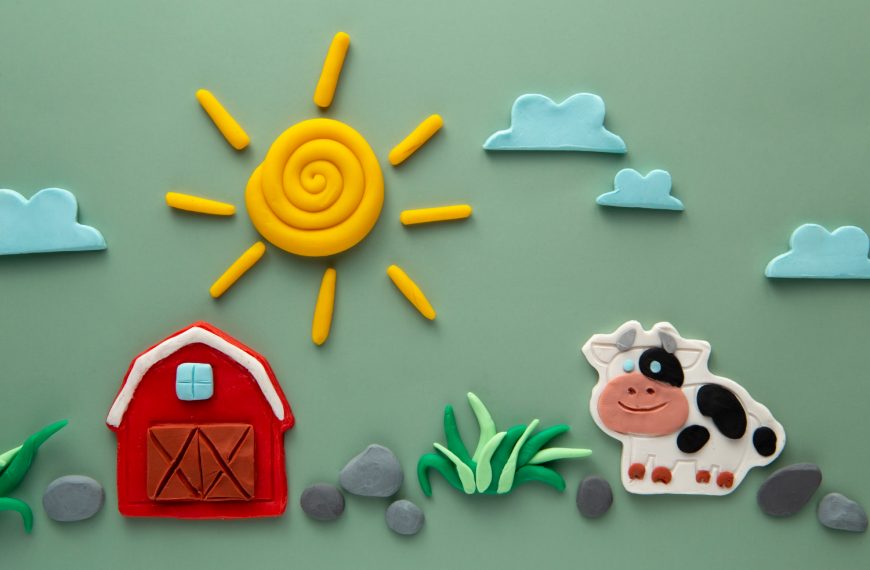Clay modelling for kids is an incredibly enjoyable and educational activity that has been popular for generations. Get ready to dive into a world of squishy, moldable fun with clay modelling for kids! Picture your child’s eyes lighting up as they transform a simple lump of clay into a wacky alien, a roaring dinosaur, or even their favourite cartoon character. So, roll up your sleeves, gather your supplies, and let’s embark on a playful adventure through the delightful world of clay art for kids!
History of Clay Modelling
The history of clay sculptures can be traced back to the earliest civilizations, with evidence of clay art dating to 25,000 BCE. These ancient pieces often served practical purposes, such as pottery and other clay sculptures, but also demonstrated the creative spirit of our ancestors. As societies evolved, so did the use of clay, becoming an essential building material for homes and structures. The importance of clay throughout human history highlights its crucial role in shaping the development of art and culture as well as learning and education.
The Evolution of Clay Modelling Techniques
Clay modelling techniques have evolved significantly over time, influenced by different civilizations’ particular practices and traditions. For example, the ancient Egyptians used clay for both useful and decorative purposes, resulting in millennia-old statues and relief. Meanwhile, ancient Greek and Roman artists worked with terracotta, a form of clay, creating lifelike sculptures and architectural features. As technology advanced, so did the tools and procedures used to sculpt clay, resulting in a varied range of styles and techniques that may still be seen today.
The Timeless Appeal of Clay Modelling
The versatility and accessibility of clay as a sculpting material have contributed to its long-lasting popularity in the world of art. Artists can express their ideas and feelings through clay by moulding and shaping it into a variety of forms. The physical modelling of sculpting clay also fosters a deep connection between the artist and their creation, infusing each piece with a unique and personal energy. As a result, clay modelling continues to captivate audiences and inspire artists in the modern era.
Clay Activities for Kids
Clay modelling is a versatile art form that encourages children to experiment with different shapes, textures, and colors. Watching a simple lump of clay transform into a beautiful, unique piece of art in the hands of a child is an amazing feeling. The possibilities are endless, as clay can be moulded into anything from animals and vehicles to abstract sculptures and decorative pieces.
The Benefits of Clay Activities for Children
Clay art for kids offers numerous developmental benefits. Here are some of the key advantages of introducing clay art to your child:
- Enhances Fine Motor Skills:
- Encourages Creativity:
- Develops Spatial Awareness:
- Boosts Concentration and Patience:
- Promotes Problem-Solving Skills:
- Enhances Social Skills:
- Provides Stress Relief:
Working with clay requires children to use their hands and fingers in precise, controlled movements. This helps to develop and strengthen their fine motor skills, which are essential for everyday tasks like writing, buttoning clothes, and tying shoelaces.
Clay modelling allows children to express themselves artistically and experiment with different forms and ideas. It gives them a secure environment in which to think creatively and develop original concepts.
The children work with clay, they become more aware of the three-dimensional space around them. This enhances their spatial awareness and comprehension of how things fit together in the real world.
Clay art for kids requires focus and patience. Children must dedicate time and effort to bring their ideas to life, which can help them develop a better attention span and learn the value of perseverance.
When faced with challenges during the clay modelling process, children must think critically and find solutions to overcome obstacles.
Clay art for kids can be a collaborative experience, allowing children to work together on group projects or share ideas and techniques. This promotes teamwork, communication, and cooperation.
Like any form of art, clay art for kids can be therapeutic for children, offering a calming and relaxing activity that allows them to unwind and express their emotions.
Choosing the Right Clay for Your Child
- Playdough:
- Air-Dry Clay:
- Polymer Clay:
- Traditional Pottery Clay:
This soft, non-toxic clay is perfect for young children as it is easy to manipulate and can be used right out of the container. Playdough is available in various colours and can be easily cleaned up after use. However, it is not suitable for permanent creations, as it tends to dry out and crumble over time.
This type of clay does not require baking and hardens by simply being exposed to air. It’s a great option for kids who want to create lasting sculptures without the need for a kiln or oven. Air-dry clay is available in various colours and finishes, making it a versatile choice for different projects.
Polymer clay is a durable, versatile option that hardens when baked in a home oven. However, because it needs more power and dexterity to manage than other varieties of clay, it might not be appropriate for very young children.
This natural clay is ideal for older children and teens who want to explore the traditional art of pottery. It requires a kiln for firing, making it more suitable for school or community art programs with access to the necessary equipment. Pottery clay allows for the creation of functional and decorative pieces that can be glazed and fired for a beautiful, professional finish.
Tips for a Fun Clay Modelling for Kids
- Set up a Dedicated Workspace:
- Provide the Right Tools:
- Encourage Exploration:
- Display their Creations:
- Offer Guidance and Support:
Create a designated area for your child’s clay activity, complete with a washable surface, storage for tools and materials, and ample lighting.
Offer a variety of tools for your child to experiment with, such as rolling pins, cookie cutters, sculpting tools, and textured materials for creating patterns and designs.
Allow your child to experiment with different techniques, styles, and materials.
Show off your child’s clay art by displaying it in your home or sharing it with friends and family. This will help boost their confidence and motivation to continue creating.
Be there to help your child when they need assistance or advice, but also give them the freedom to explore and create independently.
Conclusion
Clay modelling for kids is a fantastic way to encourage creativity, develop essential skills, and provide a fun, engaging activity for children of all ages. By introducing clay art to your child, you’ll be offering them a world of endless possibilities and a valuable outlet for self-expression. So, gather your materials, set up a workspace, and let your child’s imagination soar as they delve into the captivating world of clay modelling.
At Eurokids, we give equal importance to the development of the left brain. Our carefully curated curriculum consists of three pillars, namely, mindful learning, spaced learning, and blended learning. If you wish to know more, do visit a EuroKids centre nearby today!
For informative and accurate articles on all things related to your new born-toddler’s development, growth, health and nutrition, follow EuroKids Blogs and do check out our nationally recognized preschools – EuroKids for the first step in your kid’s educational journey!


















